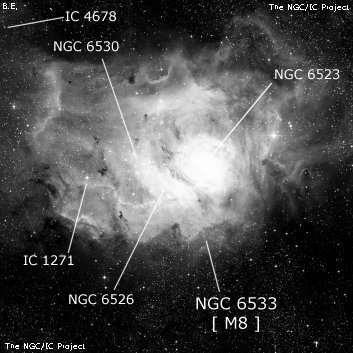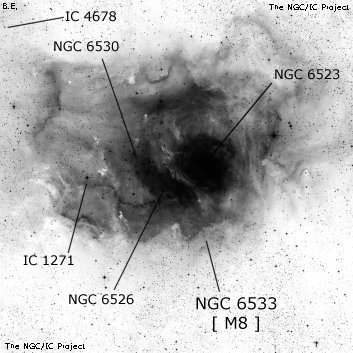NGC/IC Project Restoration Effort
(This is a very very beta version)
NGC6533


Basic Information
Location and Magnitude
Right Ascension: 18:3:42.0
Declination: -24:22:48
Constellation: SGR
Visual Magnitude: 5.8
Historic Information
Discoverer: Herschel W.
Year of discovery: 1784
Discovery aperture: 18.7
Observational
Summary description: eL, eiF, st f
Sub-type: EN
Corwin's Notes
=====
NGC 6533 = M 8 = H V 13. Here is what I had to say about this before I reread
WH's 1785 paper quoted by Glyn Jones:
WH's position for this, reduced from the offsets published in the Scientific
Papers is in a pretty empty patch of sky roughly 30 arcmin south of M 8. He
does give a pretty good description in his 1786 first catalogue, however.
He observed it only one night, 12 July 1784: "Extensive milky nebulosity
divided into 2 parts; the most northern above [larger than] 15 arcmin, the
most southern followed by stars." What struck me about this was its uncanny
similarity to his description of M 8 given in his 1785 paper (which I
unfortunately do not have a copy of), quoted by Kenneth Glyn Jones in his
fine book on the Messier objects: "An extensive milky Nebulosity divided
into two parts; the north being the strongest. Its extent exceeds 15'; the
southern part is followed by a parcel of stars which I suppose to be the 8th
of the Connaissance des Temps [i.e. M 8]." WH's 1786 description reads like
a simple condensation of his 1785 description. Is it therefore possible
that H V 13 = N6533 is M 8?
Now that I have a copy of the 1785 paper (in the 2003 reprinting of the
Scientific Papers), I see that Dreyer explicitely names WH's nebula "V. 13 =
N.G.C. 6533." Here is the rest of my earlier note on the object:
WH's position doesn't encourage that interpretation. Both JH (in GC) and
Dreyer (in WH's Scientific Papers which he edited in 1912) have notes about
WH's problems determining the position -- as I've noted, that position is
over 30 arcmin south-southeast of M 8 in a barren patch of sky. But if WH
was indeed looking at M 8, is there any way that his offsets (4m 54s
following, 38':: south of 5 Sagittarii) can be made to fit? Well, once I
tracked down 5 Sgr (it is SAO 186074, not labeled as "5 Sgr" in Sky
Catalogue 2000.0), it was clear that the NGC position was properly reduced
(once the earlier bugs found by JH had been cleaned up. He says in GC that
the offset as originally published in PT for 1786 -- 39' north -- is wrong).
Did WH observe any other nebulae that night? In particular, did he use that
same comparison star? The answers are "Yes" to both questions. H V 10, H V
11, and H V 12, all = NGC 6514 = M 20 = the well-known "Trifid Nebula" have
a single position referred to that same star on that same night. When we
reduce that position, we find that it is about 30 arcmin south-southeast of
M 20 in a barren patch of sky .... Yet there is no doubt that these three
nebulae constitute M 20 (along with IV 41); both JH and Dreyer accept that
in GC and NGC. So what's going on?
The short of it: WH may have misidentified his comparison star (but see
also N6698, found the same night, referred to a different star). He
probably used 4 Sgr = SAO 186061, rather than 5 Sgr as is printed. Once
that correction is made, it's clear that NGC 6533 is, in fact, M 8. WH's
resultant position is about a minute of time following the brightest part of
the nebula (N6523), but is more in line with the center of the entire
complex as we see it on photographs. However, as Steve and I have noted
before, WH's positions from these early runs of 1783 and 1784 have generally
larger errors than his later positions -- he was still perfecting his
observing techniques.
The mystery here is this: if JH and Dreyer knew that H V 10-12 referred to
the Trifid, why then did they not make the connection -- through the
comparison star in common -- to the Lagoon as well? I don't see an answer
to this in any of the papers I have in my collection. However, if there is
any information in WH's 1785 paper that might shed some light on this, we
should look at it again.
It's clear now that Dreyer did, in fact, make the connection between NGC 6533
and M 8. It's also annoying that he only published this in a footnote to a
paper discussing "the construction of the heavens" and not in the catalogue of
nebulae itself. While he probably would not have saved me any time in
reducing the position and finding that WH misidentified his comparison star,
he could have saved me a bit of angst over it all. Oh, well.
I finished my earlier note by simply saying:
M 8 also encompasses several other NGC and IC objects: NGC 6523, NGC 6526,
NGC 6530, IC 1271, and IC 4678, all of which see for more discussion.
Steve's Notes
=====
NGC 6533
See observing notes for NGC 6523 = M8.



